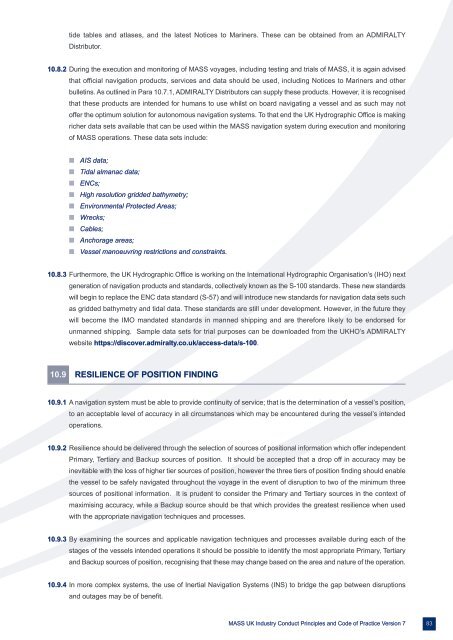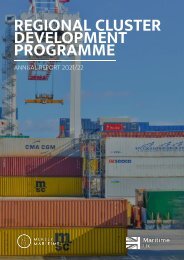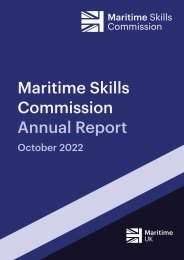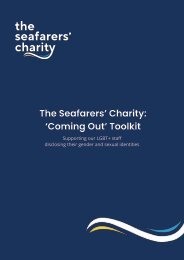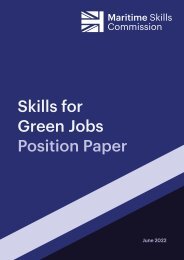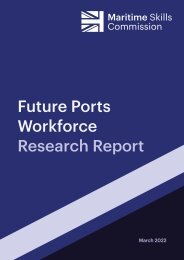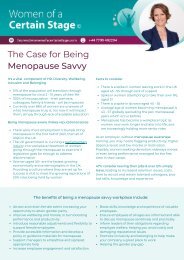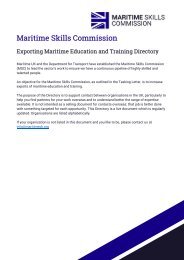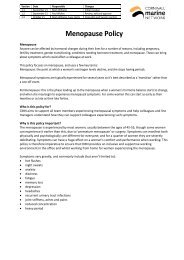COP_2023_V7_pages
Create successful ePaper yourself
Turn your PDF publications into a flip-book with our unique Google optimized e-Paper software.
tide tables and atlases, and the latest Notices to Mariners. These can be obtained from an ADMIRALTY<br />
Distributor.<br />
10.8.2 During the execution and monitoring of MASS voyages, including testing and trials of MASS, it is again advised<br />
that official navigation products, services and data should be used, including Notices to Mariners and other<br />
bulletins. As outlined in Para 10.7.1, ADMIRALTY Distributors can supply these products. However, it is recognised<br />
that these products are intended for humans to use whilst on board navigating a vessel and as such may not<br />
offer the optimum solution for autonomous navigation systems. To that end the UK Hydrographic Office is making<br />
richer data sets available that can be used within the MASS navigation system during execution and monitoring<br />
of MASS operations. These data sets include:<br />
n AIS data;<br />
n Tidal almanac data;<br />
n ENCs;<br />
n High resolution gridded bathymetry;<br />
n Environmental Protected Areas;<br />
n Wrecks;<br />
n Cables;<br />
n Anchorage areas;<br />
n Vessel manoeuvring restrictions and constraints.<br />
10.8.3 Furthermore, the UK Hydrographic Office is working on the International Hydrographic Organisation’s (IHO) next<br />
generation of navigation products and standards, collectively known as the S-100 standards. These new standards<br />
will begin to replace the ENC data standard (S-57) and will introduce new standards for navigation data sets such<br />
as gridded bathymetry and tidal data. These standards are still under development. However, in the future they<br />
will become the IMO mandated standards in manned shipping and are therefore likely to be endorsed for<br />
unmanned shipping. Sample data sets for trial purposes can be downloaded from the UKHO’s ADMIRALTY<br />
website https://discover.admiralty.co.uk/access-data/s-100.<br />
10.9 RESILIENCE OF POSITION FINDING<br />
10.9.1 A navigation system must be able to provide continuity of service; that is the determination of a vessel’s position,<br />
to an acceptable level of accuracy in all circumstances which may be encountered during the vessel’s intended<br />
operations.<br />
10.9.2 Resilience should be delivered through the selection of sources of positional information which offer independent<br />
Primary, Tertiary and Backup sources of position. It should be accepted that a drop off in accuracy may be<br />
inevitable with the loss of higher tier sources of position, however the three tiers of position finding should enable<br />
the vessel to be safely navigated throughout the voyage in the event of disruption to two of the minimum three<br />
sources of positional information. It is prudent to consider the Primary and Tertiary sources in the context of<br />
maximising accuracy, while a Backup source should be that which provides the greatest resilience when used<br />
with the appropriate navigation techniques and processes.<br />
10.9.3 By examining the sources and applicable navigation techniques and processes available during each of the<br />
stages of the vessels intended operations it should be possible to identify the most appropriate Primary, Tertiary<br />
and Backup sources of position, recognising that these may change based on the area and nature of the operation.<br />
10.9.4 In more complex systems, the use of Inertial Navigation Systems (INS) to bridge the gap between disruptions<br />
and outages may be of benefit.<br />
MASS UK Industry Conduct Principles and Code of Practice Version 7 83


